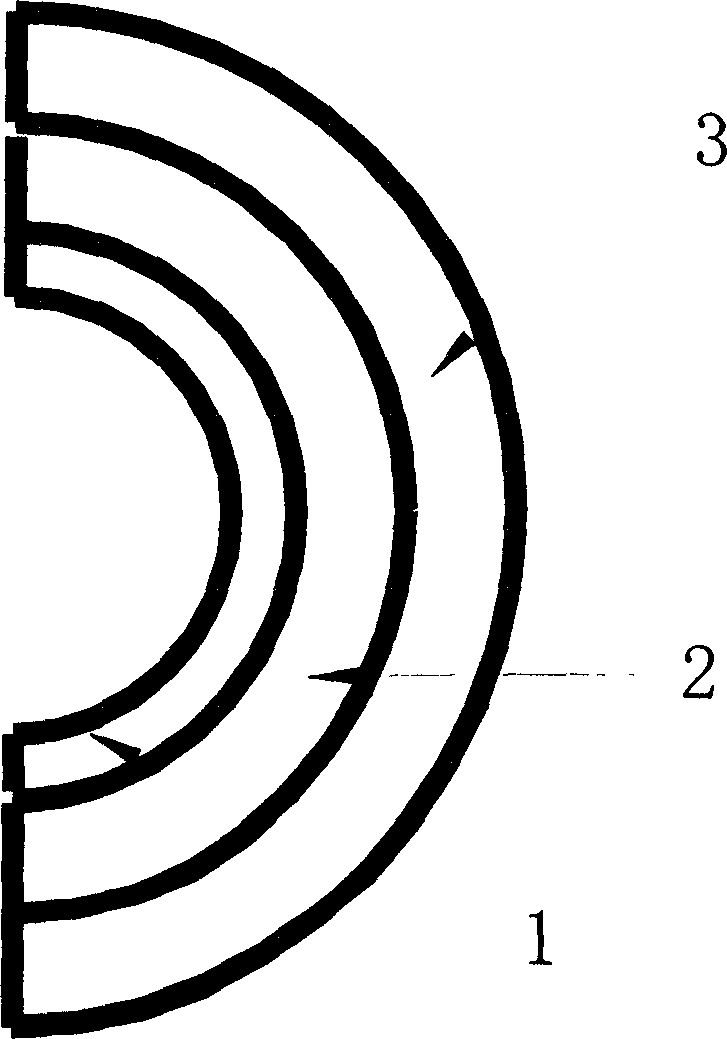Medicine coated support frame of blood vessel
A vascular stent and drug technology, applied in the field of medical devices, can solve problems such as the incidence of vascular restenosis not being effectively controlled
- Summary
- Abstract
- Description
- Claims
- Application Information
AI Technical Summary
Problems solved by technology
Method used
Image
Examples
Embodiment 1
[0056] Embodiment 1: As shown in Figure 3, a porous adsorbed drug-coated stent, the surface of the stent 4 is coated with a polymer coating 6 with micropores 5, and the drug is absorbed on the polymer coating 6 by dip coating of microwell 5. Specifically: add 10g of tetraethyl orthosilicate (TEOS) to 10g of water, then add 0.1g of HCL, mix and disperse evenly at 40°C, form a sol in 2 hours, then spray on the surface of the stent, and then place the stent in an oven at 80°C , cured for 24 hours, and then dried at 250-800°C to densify it to form a porous silica gel ceramic-coated scaffold. Then soak the stent in 1%-80% Valsartan (valsartan) or Losartan (losartan) ethanol solution for 1min-60min. After the stent is taken out, the stent is vacuum-dried at 40° C. to remove the solvent, and the valsartan or losartan drug-coated stent adsorbed by porous silica gel ceramics is prepared.
Embodiment 2
[0057] Embodiment 2: As shown in Figure 3, a porous adsorbed drug-coated stent, the surface of the stent 4 is coated with a polymer coating 6 with micropores 5, and the drug is absorbed on the polymer coating 6 by dip coating of microwell 5. Specifically: add 10g of tetraethyl orthosilicate (TEOS) to 10g of water, then add 0.1g of HCL, mix and disperse evenly at 40°C, form a sol in 2 hours, then spray on the surface of the stent, and then place the stent in an oven at 80°C , cured for 24 hours, and then dried at 250-800°C to densify it to form a porous silica gel ceramic-coated scaffold. Then immerse the stent in a dichloromethane solution of Irbesartan (irbesartan) with a concentration of 1%-60% for 1min-60min. After the stent was taken out, the stent was vacuum-dried at 40° C. to remove the solvent, and the irbesartan drug-coated stent adsorbed by porous silica gel ceramics was prepared.
Embodiment 3
[0058]Embodiment 3: As shown in Figure 3, a porous adsorbed drug-coated stent, the surface of the stent 4 is coated with a polymer coating 6 with micropores 5, and the drug is absorbed on the polymer coating 6 by dip coating of microwell 5. Specifically: add 10g of tetraethyl orthosilicate (TEOS) to 10g of water, then add 0.1g of HCL, mix and disperse evenly at 40°C, form a sol in 2 hours, then spray on the surface of the stent, and then place the stent in an oven at 80°C , cured for 24 hours, and then dried at 250-800°C to densify it to form a porous silica gel ceramic-coated scaffold. Then immerse the stent in a methanol solution of Candesartan (Candesartan) with a concentration of 1%-60% for 1min-60min. After the stent is taken out, the solvent is removed by vacuum drying at 40° C., and the candesartan drug-coated stent adsorbed by porous silica gel ceramics is prepared.
PUM
 Login to View More
Login to View More Abstract
Description
Claims
Application Information
 Login to View More
Login to View More - Generate Ideas
- Intellectual Property
- Life Sciences
- Materials
- Tech Scout
- Unparalleled Data Quality
- Higher Quality Content
- 60% Fewer Hallucinations
Browse by: Latest US Patents, China's latest patents, Technical Efficacy Thesaurus, Application Domain, Technology Topic, Popular Technical Reports.
© 2025 PatSnap. All rights reserved.Legal|Privacy policy|Modern Slavery Act Transparency Statement|Sitemap|About US| Contact US: help@patsnap.com



